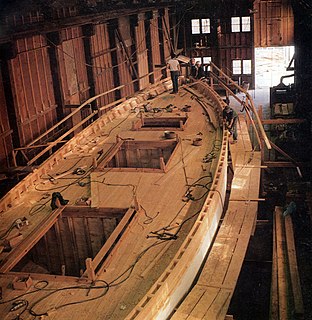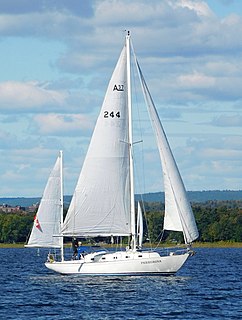
Boat building is the design and construction of boats and their systems. This includes at a minimum a hull, with propulsion, mechanical, navigation, safety and other systems as a craft requires.

The Beachcomber 6.5 is a semi-round bilge glass-reinforced plastic (GRP) trailerable keelboat designed and built in New Zealand 1970 to 1980 by Hart Brothers Marine.

The Clansman 30 is a 30-foot class of narrow-beam full-keel yacht manufactured on the New South Wales Central Coast of Australia. Production ran from 1965 through 1985, with hull numbers from 1 to 108. The last Clansman was launched in 1994.

The Baba 30 was the smallest craft in the range but very popular, with some 170 having been built. They were built as sturdy vessels suitable for making long offshore and ocean passages needing only a couple of people to crew the boat. Although capable of sleeping 5 people they are generally sailed by couples. Most of these boats can be found in NW America but are also spread all around the world's ports and anchorages.
The North 26 is a boat designed by Julian D Everitt in 1982, Cowes UK, designer of the very successful E boat. Big brother to the E-boat, intended for Yacht racing Inshore and in Junior Offshore Group races to rate under Channel now IRC measurement rule. Examples race the English Channel and have a wide flat sole plate that enables them to sit the mud in English ports with the keel retracted. This feature also enables safe beach sitting whilst cruising and use as a Trailer yacht.
The Seaway 25 was designed by Doug Peterson of USA fame for Tom Stevenson in 1978 after Tom won the World half Ton championship in one of Doug's designs. The yacht was designed to sail well on the short sharp chop of Port Phillip Bay Melbourne Australia. Intended to rate as a quarter ton Trailer yacht under IOR and Junior Offshore Group racing both for Harbour and Inshore Yacht racing.
Spray-Up also known as chop method of creating fiberglass objects by spraying short strands of glass out of a pneumatic gun. This method is used often when one side of the finished product is not seen, or when large quantities of a product must be made cheaply and quickly without regards to strength. Corvette fenders and boat dinghies are commonly manufactured this way.

The US Yachts US 22 is an American sailboat, that was designed by Gary Mull and first built in 1979.

The C&C 37/40 is a Canadian 12.05 metres (39.5 ft) LOA fibreglass monohull sailing yacht, designed in 1988 by Robert W. Ball of Cuthbertson & Cassian as a replacement for the earlier C&C 37 dating from 1981. The C&C 37/40 is a recreational keelboat of moderate displacement, intended as a cruiser/racer or oceangoing racer. The yachts have a masthead sloop rig, with a fin keel and an internally-mounted spade-type rudder. Over 110 of the 37/40 type were built before the Canadian plant closed in 1994. The design is no longer produced.

The Bluejacket 23 is a 23-foot (7.0 m) Canadian fibreglass monohull sailboat designed by Cuthbertson & Cassian as a day sailer and club racer and first built in 1967.
The C&C Landfall 39 is a sailboat that was designed by C&C Design and Robert Perry and first built in 1985. The boat has a centre cockpit deck layout, which allows for an aft cabin interior.
The Capri 25 is an American trailerable sailboat that was designed by Frank Butler as a one design racer and first built in 1980.
The Catalina 375 is an American sailboat that was designed by Gerry Douglas as a cruiser and first built in 2008.
The Watkins 36, also known as the W36 and W36AC, is an American sailboat that was designed by William H. Tripp Jr and the Watkins brothers, first built in 1981.
The Watkins 36, also known as the W36C, is an American sailboat that was designed by William H. Tripp Jr and the Watkins brothers. It was first built in 1981.
The Watkins 29, also known as the W29, is an American sailboat that was designed by Walter Scott in conjunction with the Watkins brothers and first built in 1984.
The Watkins 25, also known as the W25 and marketed as the Seawolf 25 from 1986, is an American sailboat that was first built in 1983.

The Alberg 37 is a Canadian sailboat that was designed by Carl Alberg as a racer-cruiser and first built in 1967.
The Farr 38, also called the Farr 11.6m, is a sailboat that was designed by New Zealander Bruce Farr as a racer-cruiser and first built in 1978. It is Farr Yacht Design number 72.
The Archambault A31 is a French sailboat that was designed by Joubert Nivelt Design as an IRC racer-cruiser and first built in 2009.